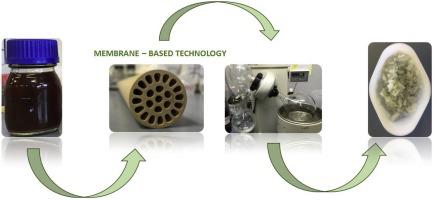当前位置:
X-MOL 学术
›
Process Biochem.
›
论文详情
Our official English website, www.x-mol.net, welcomes your feedback! (Note: you will need to create a separate account there.)
Downstream separation and purification of bio-based alpha-ketoglutaric acid from post-fermentation broth using a multi-stage membrane process
Process Biochemistry ( IF 4.4 ) Pub Date : 2020-09-01 , DOI: 10.1016/j.procbio.2020.05.026 Mateusz Szczygiełda , Krystyna Prochaska
Process Biochemistry ( IF 4.4 ) Pub Date : 2020-09-01 , DOI: 10.1016/j.procbio.2020.05.026 Mateusz Szczygiełda , Krystyna Prochaska

|
Abstract In this study, a multi-stage membrane process, assisted by vacuum evaporation and crystallization, for recovery of bio-based alpha-ketoglutaric acid from the actual post-fermentation broth was designed and investigated. In the first part of this study, pre-treatment of crude fermentation broth (centrifugation-ultrafiltration-nanofiltration) was carried out to remove biomass, proteins, sugars, part of inorganic ions and color compounds. The commercial ceramic UF membrane (15 kDa) and nanofiltration ceramic membrane (200 Da or 450 Da) were applied. Electrodialysis with a bipolar membrane was proposed for separation of ionic compounds and simultaneous electro-acidification to the acid form. During bipolar membrane electrodialysis carried out under acidic conditions, it was possible to remove close to 90 % of alpha-ketoglutaric acid. Moreover, the migration of other acids present in the fermentation broth (lactic and acetic) was significantly limited. The calculated specific energy consumption was low and equal to 0.6 kW h/kg. The final purification using crystallization assisted vacuum evaporation allowed obtaining alpha-ketoglutaric acid in solid form. Analysis of the final product showed that the proposed method of alpha-ketoglutaric acid recovery gives the acid of high purity equal to 94.8 %. Furthermore, the presented results have practical relevance and may in future be the basis for the development of separation technologies of alpha-ketoglutaric acid from the fermentation broth on industrial scale.
中文翻译:

使用多级膜工艺从发酵后肉汤中下游分离和纯化生物基 α-酮戊二酸
摘要 在这项研究中,设计并研究了一种多级膜工艺,在真空蒸发和结晶的辅助下,从实际的发酵后肉汤中回收生物基 α-酮戊二酸。本研究的第一部分对粗发酵液进行预处理(离心-超滤-纳滤),去除生物质、蛋白质、糖类、部分无机离子和有色化合物。应用商用陶瓷超滤膜(15 kDa)和纳滤陶瓷膜(200 Da 或 450 Da)。建议使用双极膜进行电渗析以分离离子化合物并同时电酸化为酸形式。在酸性条件下进行的双极膜电渗析过程中,可以去除接近 90% 的 α-酮戊二酸。而且,发酵液中存在的其他酸(乳酸和乙酸)的迁移受到显着限制。计算出的单位能耗很低,等于 0.6 kW h/kg。使用结晶辅助真空蒸发的最终纯化允许获得固体形式的α-酮戊二酸。最终产品的分析表明,所提出的 α-酮戊二酸回收方法得到了等于 94.8% 的高纯度酸。此外,所呈现的结果具有实际意义,并且可能在未来成为工业规模从发酵液中开发 α-酮戊二酸分离技术的基础。6 千瓦时/公斤。使用结晶辅助真空蒸发的最终纯化允许获得固体形式的α-酮戊二酸。最终产品的分析表明,所提出的 α-酮戊二酸回收方法得到了等于 94.8% 的高纯度酸。此外,所呈现的结果具有实际意义,并且可能在未来成为工业规模从发酵液中分离 α-酮戊二酸的技术发展的基础。6 千瓦时/公斤。使用结晶辅助真空蒸发的最终纯化允许获得固体形式的α-酮戊二酸。最终产品的分析表明,所提出的 α-酮戊二酸回收方法得到了等于 94.8% 的高纯度酸。此外,所呈现的结果具有实际意义,并且可能在未来成为工业规模从发酵液中分离 α-酮戊二酸的技术发展的基础。
更新日期:2020-09-01
中文翻译:

使用多级膜工艺从发酵后肉汤中下游分离和纯化生物基 α-酮戊二酸
摘要 在这项研究中,设计并研究了一种多级膜工艺,在真空蒸发和结晶的辅助下,从实际的发酵后肉汤中回收生物基 α-酮戊二酸。本研究的第一部分对粗发酵液进行预处理(离心-超滤-纳滤),去除生物质、蛋白质、糖类、部分无机离子和有色化合物。应用商用陶瓷超滤膜(15 kDa)和纳滤陶瓷膜(200 Da 或 450 Da)。建议使用双极膜进行电渗析以分离离子化合物并同时电酸化为酸形式。在酸性条件下进行的双极膜电渗析过程中,可以去除接近 90% 的 α-酮戊二酸。而且,发酵液中存在的其他酸(乳酸和乙酸)的迁移受到显着限制。计算出的单位能耗很低,等于 0.6 kW h/kg。使用结晶辅助真空蒸发的最终纯化允许获得固体形式的α-酮戊二酸。最终产品的分析表明,所提出的 α-酮戊二酸回收方法得到了等于 94.8% 的高纯度酸。此外,所呈现的结果具有实际意义,并且可能在未来成为工业规模从发酵液中开发 α-酮戊二酸分离技术的基础。6 千瓦时/公斤。使用结晶辅助真空蒸发的最终纯化允许获得固体形式的α-酮戊二酸。最终产品的分析表明,所提出的 α-酮戊二酸回收方法得到了等于 94.8% 的高纯度酸。此外,所呈现的结果具有实际意义,并且可能在未来成为工业规模从发酵液中分离 α-酮戊二酸的技术发展的基础。6 千瓦时/公斤。使用结晶辅助真空蒸发的最终纯化允许获得固体形式的α-酮戊二酸。最终产品的分析表明,所提出的 α-酮戊二酸回收方法得到了等于 94.8% 的高纯度酸。此外,所呈现的结果具有实际意义,并且可能在未来成为工业规模从发酵液中分离 α-酮戊二酸的技术发展的基础。



























 京公网安备 11010802027423号
京公网安备 11010802027423号